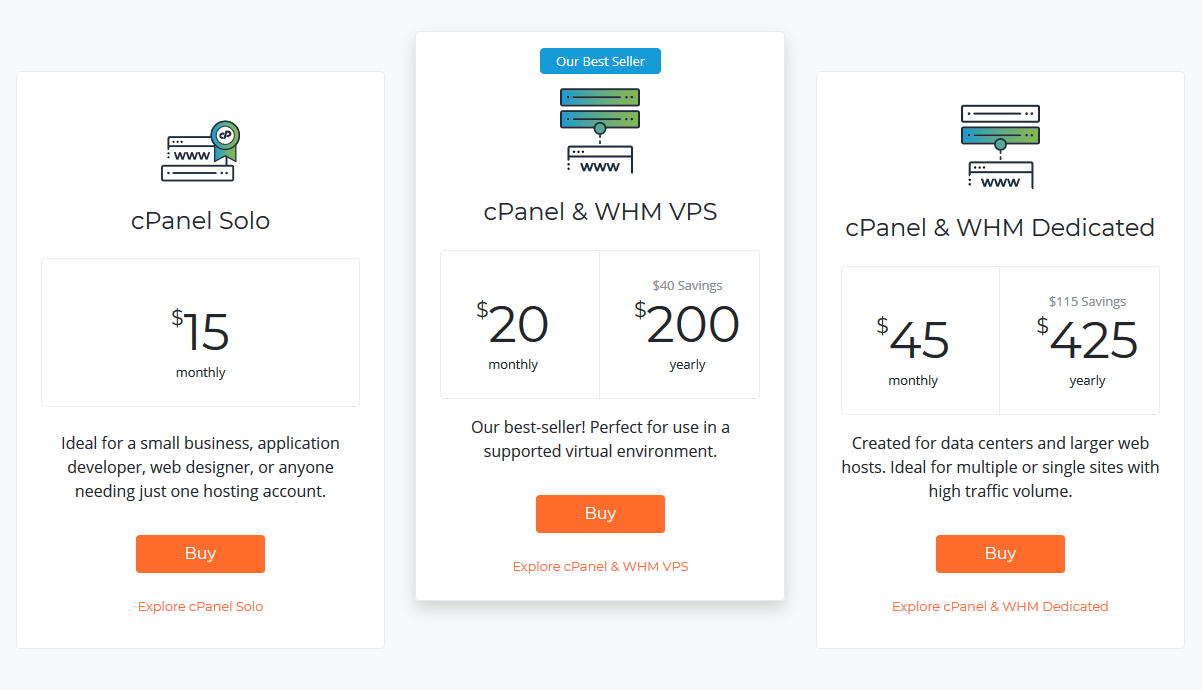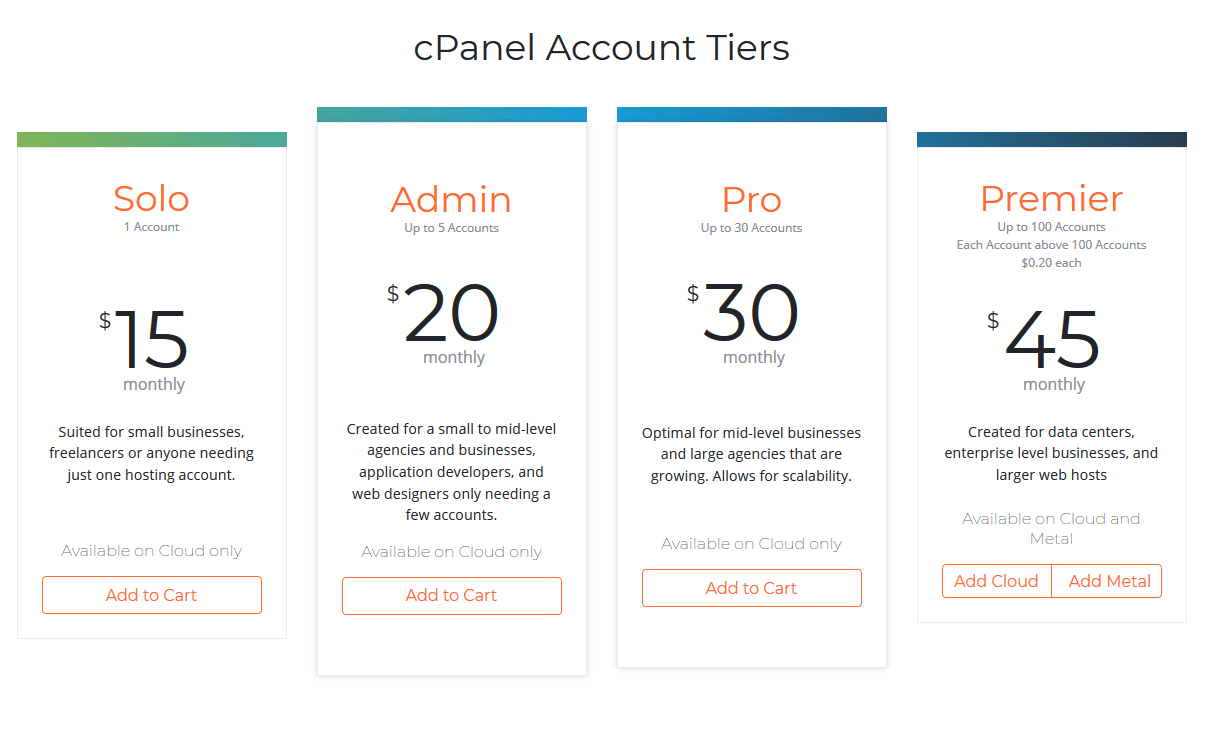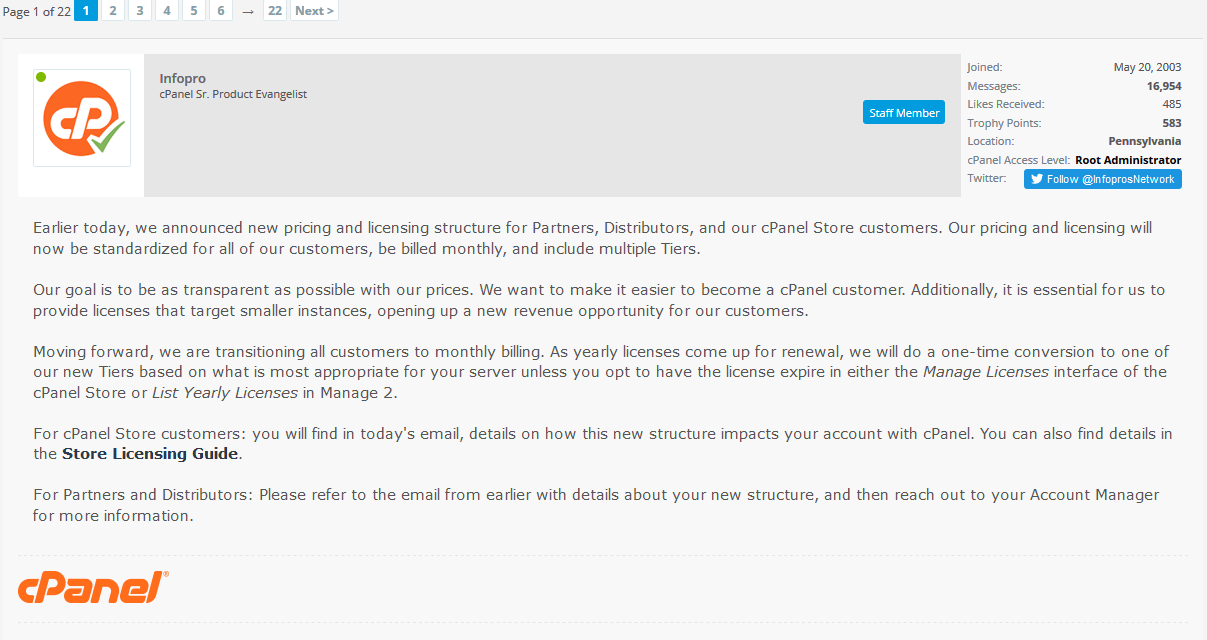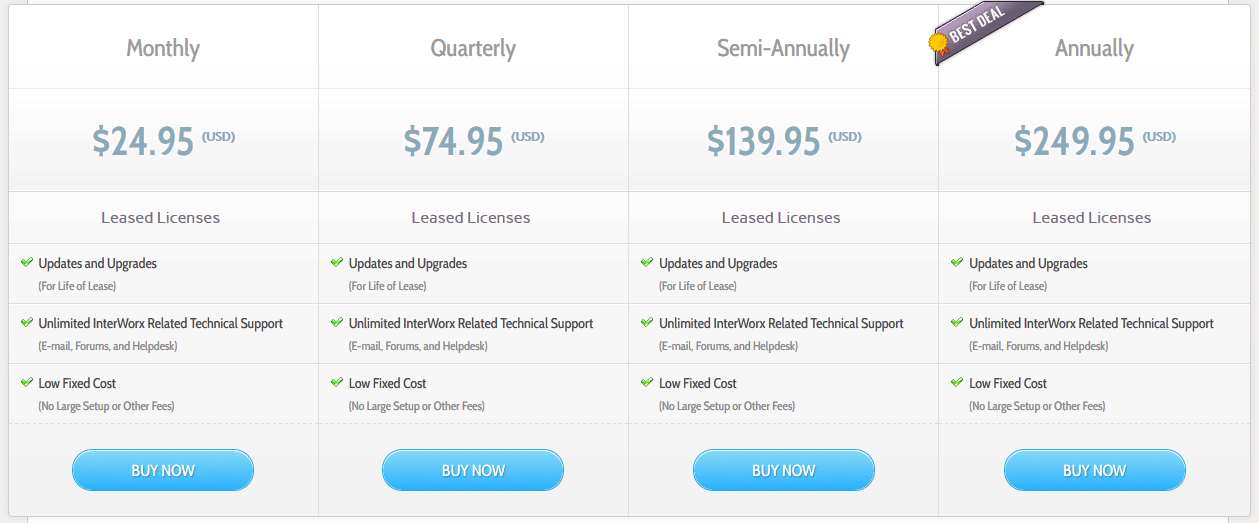June and July are the months throughout the year when most people take long vacations and enjoy the hot summertime. Businesses are slowing down, and typically no significant changes in the environment are carried into effect. This year, however, June and July will be remembered in the web community and cloud hosting industry by the shaking news around cPanel & WHM software.
What happened?
cPanel which is the most used Linux-based software for managing hosting accounts that provide a graphical interface (GUI) a.k.a. Control Panel and automation tools designed to simplify the process of hosting a website, announced a price increase. As well as a significant change in its pricing policy. cPanel announced that they are going from a per-server to a per-account model of pricing.
Old Pricing Model

See the old pricing (per server) by Archieve.org.
New Pricing Model

See the new pricing (per account) model on the cPanel site.
Why is This so Daunting for the Web Hosting Businesses and the End-Users
The new pricing method is game-changing. End-users, smaller companies, web hosting resellers, and hosting companies have worked for decades on a per-server pricing model. Millions of servers are working at the current price per server license payment.
As the license was valid for an entire server where people and businesses could manage many accounts depending on how powerful the server is and pay per server price, now the price will be converted and they’ll be billed on a per-account basis. The latter could be easily equated to a per-site basis.
A Quick Breakdown of the Old vs. New Pricing Policy
Typically, on a server, you could host from 1 up to a 1000 accounts (in some cases 1500), and with the old cPanel pricing policy the cost was around:
- $15 (long-term clients or cPanel Solo account)
- $20 (new clients) per license.
That said, the license was a reasonable price for even one account, with single website management if you are an individual who wants to use the cPanel control panel software.
On the other side, if you are a hosting provider or a reseller you could put 1000 users on a single machine. Again, paying the same price of $15 to $20. By running this business operation, you could benefit from the economy of scale and make some profit.
In the new pricing per-account model, you have to bill every single user for creating a cPanel account literally to host a website. It does have tiers (levels) though:
- 5 accounts – $20 / monthly
- 30 accounts – $30 / monthly
- 100 accounts – $45 / monthly
- 101 + account $0.20 / monthly for each additional account
Breakdown Comparison, if We Assume a Hosting Server Could Bare 1000 User Accounts
For a server with 1000 clients (most common case, see new pricing here)
| Clients | Pricing | Price per account | |
| Old pricing policy | 1000 | $20 / per server | |
| 0.02 cents / mo | |||
| New pricing policy | 1000 | General Pricing | |
| 100 accounts – $45 / mo | $0.45 cents / mo | ||
| 101 – 1000 (900 accounts) | $0.20 cents / mo | ||
| 900 x $0.20 = $180 / mo | |||
| The new policy (average) | 0.22 cents / mo | ||
| Price increase | 1000% |
For a server with 1000 clients (Licenses for Partners – if you run over 1780 accounts, see new partner pricing here)
| Clients | Pricing | Price per account | |
| Old pricing policy | 1000 | $20 / per server | |
| 0.02 cents / mo | |||
| New pricing policy | 1000 | cPanel Partner Pricing | |
| 100 accounts – $45 / mo | $0.45 cents / mo | ||
| 101 – 1000 (900 accounts) | $0.10 cents / mo | ||
| 900 x $0.10 = $90 / mo | |||
| The new policy (average) | 0.13 cents / mo | ||
| Price increase | 550% |
It seems like the new pricing policy of cPanel overall turns into a 500% to 1000% increase in the price to use the cPanel software.
Who’s going to pay the bill is the question many people in the web community are anxiously asking?
Will the end-users be the ones that will pay this huge increase or the companies providing the hosting service? The answer is yet to come.
Why is cPanel Making This Move?
To some extent, this move has its logical explanation. At least some indications for changing the current cPanel business entity state was the fact the company was acquired last year on August 20th, 2018 by Oakley Capital.
The acquisition was announced by cPanel and largely discussed by the web hosting community. Some users predicted this might happen as a consequence of the Oakley VC company’s investment in cPanel.
As financial analysts say, a venture capitalist company’s primary goal is to double, triple, or quadruple an investment typically in a short-term period, 1 – 2 years mostly.
As it always works, a more prominent company comes to buy a smaller one with a viable business case and many satisfied clients. At the moment of the announcement of the acquisition, the acquiring company claimed good intentions, and such we find in cPanel Oakley Investment FAQ:

It is a fact that a year later cPanel indeed Oakley Capital enforced higher prices, announced as a new pricing policy which cPanel claims to have “new revenue opportunity for our customers”, see the full text in cPanel Forum.
What a controversial policy of theirs in just a one-year time frame. The topic at the cPanel forum has 22+ pages with 20 posts on every page, all with negative backlash from the cPanel clients.

If you agree that the whole thing around cPanel is bad for the hosting community, here is another piece of the puzzle. Oakley Capital acquired the direct cPanel competitor Plesk just a year before cPanel on May 5th, 2017. What a coincidence!
Well, some would say, that’s how capitalism works, bigger companies sometimes purchase smaller ones. If we have to be accurate here, a capitalist economy by its characteristics “distributes goods and services according to the laws of supply and demand” and also requires free competitive markets.
Is a market competitive if a single company holds the biggest two companies in a particular sector?
Who’s Affected Mostly
It still is hard to say but generally, the densest accounts per server companies will experience the highest pressure.
From all the information we have at present the smaller companies which sell cheap hosting and have lower margins will be put against the wall.
High-pricing companies will incorporate the $0.10 price per account into their monthly bill. Some of their end clients won’t even notice it. For instance, if you pay $15 per month for high-class shared WordPress hosting, an increase of $0.10 or $0.20 per month is bearable price raise.
If these are the general cases, smaller companies will be affected the most, as their power to cope with the new situation is limited. Small hosting companies providing budget hosting solutions will probably be the ones in the most disadvantageous position.
We believe that cPanel pricing policy change and increase, however, will have a deeper impact on web hosting businesses.
Even bigger companies will be affected.
How?
Well, the more prominent hosting companies have between 500k to 1 million accounts. If they have to pay 0.10 cents per account, this is a $50 – $100k additional expense per month or $600k to over 1 million dollars a year additional expenditure. It is a substantial new financial burden, which, obviously, won’t bring any new revenue.
That said we believe that cPanel’s new pricing policy will inevitably change the web hosting market.
Alternatives to cPanel
Maybe there are no good direct alternatives to cPanel. However, alternatives exist.
DirectAdmin
It seems a good solution, and prices start at $29/month for “Unlimited Domains” meaning unlimited accounts if we remind 1 cPanel account hosts just 1 domain. If you pay annually, the price is $16 a month ($200 / year, one-time payment). See all pricing options here.
VestaCP
It runs on AWS where you can easily deploy a server with it, that would be a good solution for hosting companies who rely on AWS. Another useful feature is the Softaculous being integrated into their panel. It is a feature most of cPanel users are using and will be happy to have if they come to the point to use another panel.
And now the good part about VestaCP – it is free! Yes, you read correctly, this control panel is free. It only charges for installation support like $60/h (1 hour), $180/ for 5 hours, etc. It also has a VestaCP demo you can play with it – thank you VestaCP!
Interworx
It is a solution that provides a more complex server administrator solution. NodeWorx is a system administrator interface for managing server-wide behavior and hosting (SiteWorx) accounts.
They also have SiteWorx, which is the website owner interface that you can use to manage your domains, email, and other hosting features.
Interworks is a paying solution and costs higher, $24.95 per month. Billed annually, the price goes under the psychological $20 per month.

The price of all plans includes “Upgrades and Updates” and “Unlimited InterWorx Related Technical Support”.
This server and hosting management software has incredibly good reviews by the hosting community on WebHostingTalk. Word-of-mouth recommendation is always the best marketing a product or service could have.
In-House Developed (Proprietary) Control Panels
Many companies in the web hosting business invest in proprietary solutions. Since its creation, our company AwardSpace uses an In-House developed Control Panel, which architecture is designed to accommodate the needs of free hosting and its vast demand – many accounts on a single server without compromising quality and speed. Another advantage of having a proprietary Control Panel solution is being self-dependent, simply said it prevents our company from being dependent on the calculations of someone from the outside.
Of course, having an In-house developed Control Panel comes with a large number of pros and cons, and to evaluate whether it is worth it to dive into such an endeavor, every company should take them into account.
While the development of such software takes a considerable upfront investment, the chances are doing so will pay off in the long run.
What is more, taking into account the news around cPanel, we believe that more and more company will simply develop their own control panels, instead of paying nearly one million dollars more. The latter, of course, will be true for the bigger players, that have both the teams and the money to create an in-house hosting control panel.
The smaller companies will probably look around for a better and cheaper solution, which, as it always does, will be created by a smart and opportunistic entrepreneur.
cPanel Alternatives Conclusion
The biggest problem switching to an alternative to cPanel is that users have gotten used to cPanel. It is intuitive, and people prefer it. Changing to another interface and functionality might lead to clients dropping the hosting company.
Another good reason to stay with cPanel is the fear of having the company you choose to go out of business or stop updating the software. It will pay off to carefully research the company developing the software and its track record, such as how long it has been on the market. Are their customers happy with its product and so on.
Of course, look around for the new solutions which will surely emerge. Sooner or later.
Is it worth it from cPanel’s Business Perspective?
cPanel and its new owners decided to raise prices, and we believe they have made a proper business analysis before doing that.
It seems like, they think this is a strategy that will bring overall value to the company, instead of destroying it. Their internal or external business strategists and advisors most probably went through many economic and business models to check and prove that this strategy is a working one.
To prove it right or wrong, we decided to check this business decision against a proven business analysis framework – Porter’s Five Forces Framework and see how it stands.
A significant price increase like the one in question leads us to the presumption that the company considers there are no good alternatives on the market. In other words, the competition could not offer a substitute, and the clients would accept the price going higher meaning the brand has bargaining power over customers and competitors.
The model Five Forces of Michael Porter provides a framework model where business leaders could go into detail and check a business idea or a business decision against the following Five Forces on the market:
1. Threat of New Entrants
A significant price increase of 500% like the one described above is an event that may cause new companies to try to enter the market. According to the framework, profitable industries attract new entrants due to the profit they could make.
Factors may vary, and we will mention here the ones that will help new companies enter this market.
There are no patents, governmental, or other fixed barriers. Many companies have access to end clients and could easily offer a new solution. An example might be AWS, a dominant player with its own server infrastructure and direct client base to offer a substitute (let’s say has a powerful supply chain).
2. Threat of Substitutes
There are alternatives on the market, free and paid ones (see “Alternatives to cPanel” paragraph above).
If you read the “Who’s affected mostly” paragraph above, the smaller businesses might have no other choice but to switch to an alternative, the same may happen for the bigger companies saving them half a million a year. Although switching is, generally, something that will not happen immediately, it is a viable solution in the long term.
The threat of substitutes is a real one and being in the shoes of cPanel for this little experiment, we would have seriously considered it as a threat.
3. Bargaining Power of Customers
The bargaining power of the customers is their ability to put a company under pressure, which also affects the customer’s sensitivity to price changes.
The question here is shall companies pay the price increase in order to satisfy their clients with the same Control Panel software, switch, or gradually change to another control panel provider. The answer is unclear simply because businesses today make unbelievable things to satisfy and retain clients.
4. Bargaining Power of Suppliers
No suppliers here as it comes to a software products. A new rivalry can achieve significant market penetration in under 6 months, especially in powerful companies that have changed entire industries in the past like Amazon.
5. Competitive Rivalry
Whether there will be a competitive rivalry in the hosting software control panel industry only depends on the attractiveness of the industry. It is an attractive industry as the whole world is going digital, servers, web-based systems, and websites demand will increase in the future.
That said the industry surely would attract more players to offer software for managing hosting servers and accounts. According to the 5 forces a company has to have a competitive advantage to resist on market saturation and a potential competitive rivalry.
The only single competitive advantage of cPanel is its brand recognition and its client’s loyalty, which, however, has been shaken vigorously by the pricing model change.
Conclusion
So, is it worth it from cPanel’s Perspective? It is definitely a bold move, causing too many negative feelings against cPanel.
The 5 Forces analysis above shows the good position of the company at present due to its popularity. However, it shows as well that there aren’t many barriers to protect cPanel from the competition or a market entry of a new rival.
Therefore, in the long-term, a stronger competition compared to the state before the announcement of the price jump is to be expected.
Who will be the winner and the loser of all this? It seems cPanel easily put a significant part of the hosting customers against the wall. It seems the battle will be won, but they might lose the war strategically.
Whether cPanel’s unexpected and almost immediately effective pricing policy change will turn out to be an example of a hasty and foolish business decision in the economic and marketing books is yet to be seen!
